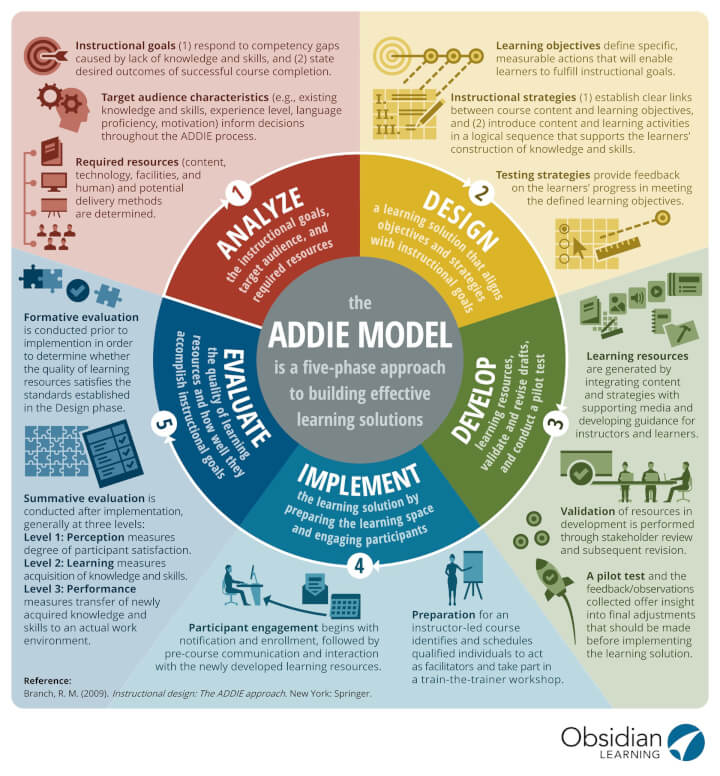Trying to master a new skill without guidance is no easy task. Without it, learners end up with major knowledge gaps in the basics that can greatly affect their learning. Whether you're teaching in a classroom or training employees, instructional design ensures that learning experiences are purposeful, impactful, and tailored to the needs of the audience.
What is instructional design?
Instructional design blends the science of learning with creative techniques to create engaging, effective training programs. It uses what we know about how people learn with proven educational strategies to deliver the best training outcomes.

Early days of instructional design
The early days of instructional design date back to World War II when educational psychologist Robert M. Gagné developed methods to train U.S. Air Force pilots. He realized that different types of learning required different instructional approaches. Gagné’s work is the basis for instructional design as we know it today, shaping it as a systematic way to create effective educational programs.
As education evolved, so did the frameworks supporting it. Over the years, instructional design has expanded, becoming an integral part of corporate training, higher education, and online learning environments. Today, its principles are used across industries to foster skill development across the board.
Instructional design models
A well-designed course curriculum is key to a smooth learning experience. There are three different types of curriculum design:
Subject-centered design. Remember high school math? This is an example of subject-centered curriculum design–the topic that had to be taught was clear, and a curriculum was designed around it.
Learner-centered design. This type of curriculum design is based on the individuality of the learner. It empowers learners and gives them choices in how, when, and what they want to learn.
Problem-centered design. As the name suggests, this type of curriculum design focuses on real-world issues and creates a curriculum around them to help learners formulate solutions specific to the problem.
Several key models and principles have been developed over decades as ways to approach instructional design. The five most influential ones are:
-
ADDIE Model
One of the most widely used models, ADDIE stands for Analysis, Design, Development, Implementation, and Evaluation.

It provides a specific process to guide the creation of instructional materials. Each phase guides the next, with a focus on continuous reflection and improvement.
-
Gagné’s Nine Events of Instruction
Robert Gagné’s Nine Events of Instruction offer a clear pathway for structuring lessons that promote effective learning:
- Gain attention
- Inform learners of objectives
- Stimulate recall of prior learning
- Present the content
- Provide learner guidance
- Elicit performance
- Provide feedback
- Assess performance
- Enhance retention and transfer of knowledge
-
Bloom’s Taxonomy
Bloom’s framework separates learning into six levels: Knowledge, Comprehension, Application, Analysis, Synthesis, and Evaluation. It is widely used to build critical thinking and problem-solving in K-12 and higher education.
-
Merrill’s Principles of Instruction
Merrill's approach is task-centered, emphasizing real-world application through Activation, Demonstration, Application, and Integration of knowledge.
-
Iterative Design and the SAM Model
Unlike traditional linear models, Iterative Design promotes continuous improvement through feedback and testing. The Successive Approximation Model (SAM) refines this by encouraging rapid prototyping and frequent iterations.
Best practices for launching your own course
Download the free step-by-step guide on how to develop an online training course.
9 principles of instructional design
That being said, let's expand on Gagné's 9 foundational principles of instructional design without getting too deep into the weeds.
1. Gain attention
You have one chance to make a first impression on your learners. Just like a good book should hook a reader in from the first paragraph, a training program should pique a learner’s interest straight away.
2. Set learning objectives
Communicating goals and objectives clearly is a major part of instructional design. What do you want your learners to take away at the end? What skills should they be able to practice and apply once they’ve finished your course?
3. Recall prior knowledge
Most of us don’t start learning any subject from an entirely blank slate. There will likely be something your learners already know about the subject at hand. Understanding what they already know will allow you to adjust your lessons and keep them engaged.
4. Present the content
Finally, the fun part. Use your creativity to present the content to your learners by using a variety of different mediums, gamification, and a dash of storytelling to keep your audience engaged. With the GoSkills course builder, you can create fun and interactive courses with quizzes, images, text, and video or use a content authoring tool to create custom content in just a few minutes.
5. Provide guidance
No matter how well presented your content is, your learners will undoubtedly have some questions along the way. Be there for them as they move through your course and content. Provide guidance by welcoming and answering any questions they may have.
6. Repeat it
New knowledge is fantastic. But if you don’t know how to apply it to your work or personal life, it’s of little use. One of the best ways to ensure knowledge sticks is to repeat it. Not necessarily word for word. Instead, you can get your learners to either paraphrase or practice the concept or skill they’ve just learned. This allows the information to gain a foothold in their brain, enabling your learners to apply the information more easily.
7. Provide feedback
Instead of just giving your learners feedback only after they’ve finished the course, it’s much more helpful to them if you provide feedback while they move through the learning content. The feedback can be vocal, where you check in with your learners and talk through what they’ve recently learned. It can also be in the form of assignments, games, and exercises throughout the course.
8. Evaluate performance
Have your learners take short quizzes throughout the course to see where they’re at, and to verify whether they understand the concepts you’re trying to get across. When creating courses with the GoSkills course builder, you can easily add knowledge assessments through block-style content creation, encouraging greater learning retention at every step.
9. Enhance retention
This final step goes hand in hand with step 6 (repeat it). For both of these steps, your learners need to retain and apply the lessons they’ve learned. There’s no point in learning new information only to let it remain untapped even when the opportunity to apply it in different contexts arises.
Go from rookie to rockstar
Learn how to create your own online training course in 9 free bite-sized lessons!
Start nowApplication of instructional design
Today, instructional design plays a huge role in upskilling and reskilling workers. Instructional designers focus on creating interactive, personalized learning experiences that are engaging and easily applied in the real world.
The trajectory of instructional design continues to shift as new technological advancements are popularized and integrated. For example, Learning Management Systems (LMSs) and AI-driven tools have transformed how training programs are delivered, making them more flexible and accessible. This has been particularly significant in remote work environments where employees need engaging content that can be accessed anytime, anywhere.
Platforms like GoSkills LMS offer tools that enable organizations to develop immersive, media-rich courses that cater to diverse learning styles. Elements like quizzes, videos, and simulations allow learners to apply knowledge in real time, making learning more dynamic and effective.

Learn more: How to Prompt-Engineer With an AI Elearning Authoring Tool
Instructional design is the foundation of effective education and training. By combining the theoretical of learning with technological advances, instructional design ensures that learners are equipped with the tools and experiences they need to succeed. Technology has played a key role in modern instructional design, making learning more accessible and effective for diverse learners. The collaboration between instructional design and technology helps to create learning experiences that are engaging and sustainable.
Go from rookie to rockstar
Learn how to create your own online training course in 9 free bite-sized lessons!
Start now



